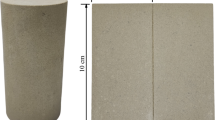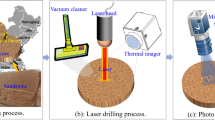Abstract
Geophysical flows like rock–ice avalanches have high mobility and destructive potential, causing global loss of life and property. Water, often from melted ice, significantly impacts their mobility. Experimental investigations of debris friction in a rotating drum with melting ice show reduced friction due to water. However, experimental limitations hinder extensive testing. Employing a numerical model can overcome this, facilitating the study of various scenarios in understanding such calamitous geophysical flows. In the current work, we numerically replicate the rotating drum experiment using Eulerian–Lagrangian CFD–DEM coupling. We focus on the initial and final states, considering a \(30\%\) gravel and \(70\%\) ice mixture (B12-070 ). We don’t model the ice melting; rather, we inject equivalent water over time. Our simulation captures changes in the frictional behavior of the gravel bulk and flow height profile, closely aligning with experimental observations.















Similar content being viewed by others
Abbreviations
- \(c_\textrm{p}\) :
-
Specific heat (J/(kg K))
- d :
-
Particle diameter (m)
- \(I_\textrm{i}\) :
-
Moment of inertia (kg \(\textrm{m}^2\))
- m :
-
Mass (kg)
- \(m'\) :
-
Mass source (kg/\(\textrm{m}^3\) s)
- p :
-
Pressure (Pa)
- \(q'\) :
-
Heat source (W/\(\textrm{m}^2\))
- \(q''\) :
-
Heat flux (W/\(\textrm{m}^2\))
- r, R :
-
Radius (m)
- t :
-
Time (s)
- T :
-
Temperature (K)
- \(T_{\textrm{final}}\) :
-
Length of simulation (s)
- \(\vec {g}\) :
-
Acceleration due to gravity (m/s)
- \(\vec {F^\textrm{c}}\) :
-
Contact forces (N)
- \(\vec {F^\textrm{g}}\) :
-
Gravitational force (N)
- \(\vec {F^{\textrm{ext}}}\) :
-
External forces (N)
- \(\vec {F_\textrm{B}}\) :
-
Buoyancy force (N)
- \(\vec {F_\textrm{D}}\) :
-
Drag force (N)
- \(\vec {M_{i,j}}\) :
-
Torque generated by interparticle forces (N m)
- \(\vec {S}\) :
-
Momentum source due particles
- \(\vec {v}_\textrm{f}\) :
-
Fluid velocity field
- \(\vec {X_i}\) :
-
Positional vector (m)
- \(\vec {\omega }\) :
-
Rotational velocity (rad/s)
- \(\alpha \) :
-
Heat transfer coefficient (W/(m K))
- \(\beta \) :
-
Momentum exchange (kg/(\(\textrm{m}^3\) s)
- \(\partial \) :
-
Differential operator (–)
- \(\epsilon \) :
-
Volume fraction/porosity (–)
- \(\mu \) :
-
Kinematic viscosity (Pa s)
- \(\nabla \) :
-
Nabla operator (–)
- \(\rho \) :
-
Density (kg/\(\textrm{m}^3\))
- c:
-
Cell
- cond:
-
Conduction
- eff:
-
Effective values
- f:
-
Fluid
- i, j :
-
Particle
- n:
-
Normal direction
- p, P:
-
Particle
- rad:
-
Radiation
- t:
-
Tangential direction
References
Alexander D (1989) Urban landslides. Prog Phys Geogr 13(2):157–189
Baniasadi M, Baniasadi M, Peters B (2018) Coupled CFD–DEM with heat and mass transfer to investigate the melting of a granular packed bed. Chem Eng Sci 178:136–145
Berberović E, van Hinsberg NP, Jakirlić S, Roisman IV, Tropea C (2009) Drop impact onto a liquid layer of finite thickness: dynamics of the cavity evolution. Phys Rev E 79(3):036306
Biot MA (1956) Theory of propagation of elastic waves in a fluid-saturated porous solid. II. Higher frequency range. J Acoust Soc Am 28(2):179–191
Denlinger RP, Iverson RM (2004) Granular avalanches across irregular three-dimensional terrain: 1. Theory and computation. J Geophys Res Earth Surf. https://doi.org/10.1029/2003JF000085
Fan X, Yunus AP, Yang YH, Subramanian SS, Zou C, Dai L, Dou X, Narayana AC, Avtar R, Xu Q et al (2022) Imminent threat of rock–ice avalanches in high mountain Asia. Sci Total Environ 836:155380
Fang J, Cui Y, Li X, Nie J (2022) A new insight into the dynamic impact between geophysical flow and rigid barrier. Comput Geotech 148:104790
Hertz H (1882) Ueber die berührung fester elastischer körper
Hürlimann M, Copons R, Altimir J (2006) Detailed debris flow hazard assessment in Andorra: a multidisciplinary approach. Geomorphology 78(3–4):359–372
Iverson RM, Denlinger RP (2001) Flow of variably fluidized granular masses across three-dimensional terrain: 1. Coulomb mixture theory. J Geophys Res Solid Earth 106(B1):537–552
Iverson RM, George DL (2014) A depth-averaged debris-flow model that includes the effects of evolving dilatancy. I. Physical basis. Proc R Soc A Math Phys Eng Sci 470(2170):20130819
Jing L, Kwok C, Leung YF, Sobral Y (2016) Extended CFD–DEM for free-surface flow with multi-size granules. Int J Numer Anal Meth Geomech 40(1):62–79
Kong Y, Guan M, Li X, Zhao J, Yan H (2022) How flexible, slit and rigid barriers mitigate two-phase geophysical mass flows: a numerical appraisal. J Geophys Res Earth Surf 127(6):e2021JF006587
Laigle D, Coussot P (1997) Numerical modeling of mudflows. J Hydraul Eng 123(7):617–623
Li X, Zhao J (2018) Dam-break of mixtures consisting of non-Newtonian liquids and granular particles. Powder Technol 338:493–505
Mahmoudi AH, Hoffmann F, Peters B (2014) Application of XDEM as a novel approach to predict drying of a packed bed. Int J Therm Sci 75:65–75
Mahmoudi AH, Markovic M, Peters B, Brem G (2015) An experimental and numerical study of wood combustion in a fixed bed using Euler–Lagrange approach (XDEM). Fuel 150:573–582
Mahmoudi AH, Hoffmann F, Peters B (2016) Semi-resolved modeling of heat-up, drying and pyrolysis of biomass solid particles as a new feature in XDEM. Appl Therm Eng 93:1091–1104
Mindlin RD (1949) Compliance of elastic bodies in contact
Peters B, Baniasadi M, Baniasadi M, Besseron X, Donoso AE, Mohseni M, Pozzetti G (2019) XDEM multi-physics and multi-scale simulation technology: review of DEM–CFD coupling, methodology and engineering applications. Particuology 44:176–193
Pitman EB, Le L (2005) A two-fluid model for avalanche and debris flows. Philos Trans R Soc A Math Phys Eng Sci 363(1832):1573–1601
Pouliquen O, Forterre Y (2002) Friction law for dense granular flows: application to the motion of a mass down a rough inclined plane. J Fluid Mech 453:133–151
Pozzetti G, Peters B (2018) A multiscale DEM–VOF method for the simulation of three-phase flows. Int J Multiph Flow 99:186–204
Pudasaini S, Wang Y, Hutter K (2005) Modelling debris flows down general channels. Nat Hazard 5(6):799–819
Pudasaini SP (2012) A general two-phase debris flow model. J Geophys Res Earth Surf. https://doi.org/10.1029/2011JF002186
Pudasaini SP, Fischer JT (2020) A mechanical model for phase separation in debris flow. Int J Multiph Flow 129:103292
Pudasaini SP, Hutter K (2007) Avalanche dynamics: dynamics of rapid flows of dense granular avalanches. Springer Science & Business Media, Berlin
Pudasaini SP, Mergili M (2019) A multi-phase mass flow model. J Geophys Res Earth Surf 124(12):2920–2942
Sandia National Labs, Kitware Inc and Los Alamos National Labs (2000–2008) Paraview: parallel visualization application. http://paraview.org
Savage SB, Hutter K (1989) The motion of a finite mass of granular material down a rough incline. J Fluid Mech 199:177–215
Savage SB, Hutter K (1991) The dynamics of avalanches of granular materials from initiation to runout. Part I: analysis. Acta Mech 86(1–4):201–223
Schiller L (1933) A drag coefficient correlation. Zeit Ver Deutsch Ing 77:318–320
Schneider D, Kaitna R, Dietrich W, Hsu L, Huggel C, McArdell B (2011) Frictional behavior of granular gravel–ice mixtures in vertically rotating drum experiments and implications for rock–ice avalanches. Cold Reg Sci Technol 69(1):70–90
Shan T, Zhao J (2014) A coupled CFD–DEM analysis of granular flow impacting on a water reservoir. Acta Mech 225:2449–2470
Shugar DH, Jacquemart M, Shean D, Bhushan S, Upadhyay K, Sattar A, Schwanghart W, McBride S, De Vries MVW, Mergili M et al (2021) A massive rock and ice avalanche caused the 2021 disaster at Chamoli, Indian Himalaya. Science 373(6552):300–306
Sosio R, Crosta GB, Chen JH, Hungr O (2012) Modelling rock avalanche propagation onto glaciers. Quat Sci Rev 47:23–40
Takebayashi H, Fujita M (2020) Numerical simulation of a debris flow on the basis of a two-dimensional continuum body model. Geosciences 10(2):45
Taylor-Noonan AM, Bowman ET, McArdell BW, Kaitna R, McElwaine JN, Take WA (2022) Influence of pore fluid on grain-scale interactions and mobility of granular flows of differing volume. J Geophys Res Earth Surf 127(12):e2022JF006622
Trujillo-Vela MG, Ramos-Cañón AM, Escobar-Vargas JA, Galindo-Torres SA (2022) An overview of debris-flow mathematical modelling. Earth Sci Rev. https://doi.org/10.1016/j.earscirev.2022.104135
Tsuji Y, Tanaka T, Ishida T (1992) Lagrangian numerical simulation of plug flow of cohesionless particles in a horizontal pipe. Powder Technol 71(3):239–250
Wang T, Zhang F, Furtney J, Damjanac B (2022) A review of methods, applications and limitations for incorporating fluid flow in the discrete element method. J Rock Mech Geotech Eng 14(3):1005–1024
Xiao H, Sun J (2011) Algorithms in a robust hybrid CFD–DEM solver for particle-laden flows. Commun Comput Phys 9(2):297–323
Xu WJ, Dong XY (2021) Simulation and verification of landslide tsunamis using a 3D SPH–DEM coupling method. Comput Geotech 129:103803
Xu WJ, Yao ZG, Luo YT, Dong XY (2020) Study on landslide-induced wave disasters using a 3D coupled SPH–DEM method. Bull Eng Geol Env 79:467–483
Zhang D, Whiten W (1996) The calculation of contact forces between particles using spring and damping models. Powder Technol 88(1):59–64
Zhao T, Houlsby G, Utili S (2014) Investigation of submerged debris flows via CFD–DEM coupling. IS-Cambridge, Geomechanics from Micro to Macro Taylor and Francis Group, Cambridge, pp 497–502
Acknowledgements
PA contributed to conceptualization, methodology, software, validation, formal analysis, investigation, figures, writing—original draft, and review revision and editing; ZF contributed to conceptualization, methodology, writing—original draft, and review revision and editing; TN performed review revision; BP performed review revision and supervision; XF contributed to funding acquisition, review revision and supervision.
Funding
This research is financially supported by the National Science Fund for Distinguished Young Scholars of China (Grant No. 42125702); Tencent Foundation through the XPLORER PRIZE (Grant No. XPLORER-2022-1012); Natural Science Foundation of Sichuan Province (Grant Nos. 22NSFSC0029 and 2023NSFSC0808); and National Natural Science Foundation of China (Grant No. 42207226). The numerical experiments presented in this paper were carried out using the HPC facilities of the University of Luxembourg—see https://hpc.uni.lu.
Author information
Authors and Affiliations
Corresponding author
Ethics declarations
Conflict of interest
The authors declare that they have no known competing financial interests or personal relationships that could have appeared to influence the work reported in this paper.
Additional information
Publisher's Note
Springer Nature remains neutral with regard to jurisdictional claims in published maps and institutional affiliations.
Rights and permissions
Springer Nature or its licensor (e.g. a society or other partner) holds exclusive rights to this article under a publishing agreement with the author(s) or other rightsholder(s); author self-archiving of the accepted manuscript version of this article is solely governed by the terms of such publishing agreement and applicable law.
About this article
Cite this article
Adhav, P., Feng, Z., Ni, T. et al. Numerical insights into rock–ice avalanche geophysical flow mobility through CFD–DEM simulation. Comp. Part. Mech. (2024). https://doi.org/10.1007/s40571-023-00699-3
Received:
Revised:
Accepted:
Published:
DOI: https://doi.org/10.1007/s40571-023-00699-3




